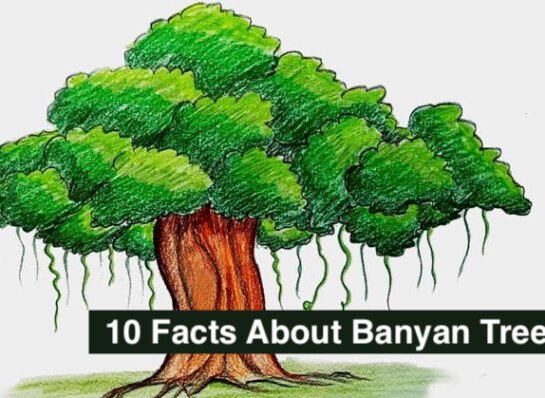10 Facts About Banyan Tree Every Indian Should Know | Scientific Name

- The banyan tree is a plant that grows on another plant when its seed germinates in a crack or fissure of a host tree or pile. Its scientific name is “Ficus benghalensis“, and is native to the Indian subcontinent. It is also the national tree of India.
- Usually, it reaches up to the heights of over 100 feet, making it quite a large tree. It also grows sideways, covering a broad area – this means one tree, given adequate time, will look like an impenetrable thicket, as a result of the tangled trunks and roots.
- Frugivore birds scatter the seeds of banyans. The seeds are tiny, and since most banyans grow in woodlands, a seedling that sprouts on the ground is unlikely to survive. Nevertheless, many seeds drop on the branches and stems of other trees, and when they germinate, their roots grow down toward the ground and consequently envelop part of the host tree or structure. For this reason, banyans bear the familiar name “strangler fig”.
- The Indian banyan tree relates to the genus Ficus, which includes many other species such as F. Elastica, F. microcarpa, F. macrophylla, F. citrifolia, F. pertusa and more. “Thimmamma Marrimanu” of Andhra Pradesh, India is one particular specimen which has the broadest canopy of any tree in the world.
14 Animals Whose Blood Isn’t Red
10 Facts About Banyan Tree
1. The banyan tree is one of more than 750 species of fig trees, each of which is cross-fertilised only by its own kind of tiny wasps that reproduce only inside the figs of their partner trees.
2. Banyans are familiar as strangler figs. They originate from seeds that settle on other trees. They grow roots to send down and smother their hosts to grow into stout, branch-supporting columns that resemble new tree trunks.
3. Area-wise Banyan trees are the biggest trees in the world. The biggest one existing today is in the Indian state of Andhra Pradesh covering an area of 1.9 hectares (4.7 acres) and can shelter 20,000 people.
4. Banyans are eco-friendly linchpins. They produce large crops of figs that nurtures many species of birds, fruit bats, primates and other creatures, which in turn scatter the seeds of hundreds of other plant varieties.
5. The first Europeans to confront banyan trees were Alexander the Great and his army, who reached India in 326 BCE. The records they took back to Greece notified Theophrastus, the patron of modern botany, and — finally — led 17th-century English poet John Milton to write in Paradise Lost that Adam and Eve made the first garments from banyan leaves.
6. Hindus believe that a banyan tree at Jyotisar is the one Krishna stood under when he gave the sermon of the Bhagavad Gita.
7. For thousands of years, banyans were the sources of medicines. Even today in Nepal, people apply banyan leaves, bark and roots to heal more than twenty ailments.
8. Ancient Hindu texts written more than 2500 years ago depict a cosmic ‘world tree’, a banyan growing inverted with its roots in the heavens. Its trunk and branches spread to Earth to bring blessings to humanity.
9. During British rule in India, the Britains hanged hundreds of dissidents to their deaths from banyan trees. Later on, independent India made the banyan as its national tree.
10. Banyans in Hawaii are not native. Franklin D. Roosevelt, Richard Nixon, Amelia Earhart and Louis Armstrong have planted them.
Get Free “Winspire Digital Worksheets of worth Rs. 129 Value”
Please enter your details to get the monthly E – Booklet + absolutely premium content to expand your horizons.


